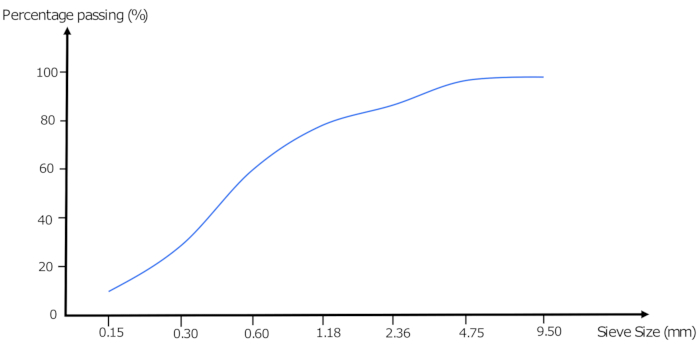5.3 : Analiza sitowa i krzywe klasyfikacji
Analiza sitowa to metoda stosowana do określania rozkładu wielkości cząstek materiałów kruszywowych. Proces ten obejmuje następujące kroki:
- Odważa się wymaganą ilość wysuszonej próbki kruszywa.
- Zważone kruszywa przesiewa się przez zestaw sit o kwadratowych otworach ułożonych w kolejności malejącej według wielkości oczek, przy czym największe oczka znajdują się na górze (kolumna 1 tabeli 1).
- Stos sit jest potrząsany lub wprawiany w drgania w celu ułatwienia sortowania cząstek według wielkości.
- Po przesianiu przez określony czas, materiał zatrzymany na każdym sicie jest ważony (kolumna 2 tabeli 1).
- Masę cząstek zatrzymanych na każdym sicie wyraża się jako procent całkowitej masy próbki (kolumna 3 tabeli 1).
- Skumulowany procent przechodzący przez każde sito oblicza się z dokładnością do jednego procenta od najdrobniejszego sita przesuwając się ku górze (kolumna 4 tabeli 1).
- Krzywą oceniania przedstawiono na wykresie (rysunek 1), gdzie wartości na osi rzędnych oznaczają procent zaliczeń (kolumna 4 tabeli 1), a wartości na osi odciętych pokazują otwory sita (kolumna 1 tabeli 1) ustawione w skali logarytmicznej.
Tabela 1: Dane do analizy sitowej piasku
| Kolumna 1 | Kolumna 2 | Kolumna 3 | Kolumna 4 |
| Sito ASTM (Rozmiar sita) | Masa zatrzymana na każdym sicie (g) | Procentowa masa zatrzymana na każdym sicie (%) | Skumulowany procent przechodzący przez każde sito (%) |
| ⅜ cala (9.5 mm) | 0 | 0 | 98+2 = 100 |
| Nr 4 (4.75 mm) | 10 | 2 | 88+10 = 98 |
| Nr 8 (2.36mm) | 50 | 10 | 79+9 = 88 |
| Nr 16 (1.18 mm) | 45 | 9 | 61+18 = 79 |
| Nr 30 (600 µ) | 90 | 18 | 29+32 = 61 |
| Nr 50 (300 µ) | 160 | 32 | 10+19 = 29 |
| Nr 100 (150 µ) | 95 | 19 | 10 |
| Dolne naczynie | 50 | 10 | |
| Całkowita masa kruszywa = 500 g | |||

Krzywe uziarnienia upraszczają wizualnie rozkład wielkości cząstek i są niezbędne do zapewnienia, że kruszywa spełniają wymagane specyfikacje uziarnienia dla projektów budowlanych.
Z rozdziału 5:

Now Playing
5.3 : Analiza sitowa i krzywe klasyfikacji
Aggregates and Water
313 Wyświetleń

5.1 : Niesolidność agregatu spowodowana zmianą głośności
Aggregates and Water
98 Wyświetleń

5.2 : Substancje szkodliwe w ujęciu zbiorczym
Aggregates and Water
153 Wyświetleń

5.4 : Moduł rozdrobnienia
Aggregates and Water
284 Wyświetleń

5.5 : Rodzaje klasyfikacji kruszywa
Aggregates and Water
426 Wyświetleń

5.6 : Maksymalny rozmiar kruszywa
Aggregates and Water
86 Wyświetleń

5.7 : Jakość wody
Aggregates and Water
87 Wyświetleń

5.8 : Testowanie jakości wody
Aggregates and Water
103 Wyświetleń

5.9 : Klasyfikacja kruszyw
Aggregates and Water
305 Wyświetleń

5.10 : Kształt i tekstura grubych kruszyw
Aggregates and Water
197 Wyświetleń

5.11 : Wiązanie i wytrzymałość kruszywa
Aggregates and Water
140 Wyświetleń

5.12 : Wytrzymałość i twardość kruszywa
Aggregates and Water
248 Wyświetleń

5.13 : Gęstość właściwa kruszyw
Aggregates and Water
223 Wyświetleń

5.14 : Gęstość nasypowa kruszywa
Aggregates and Water
417 Wyświetleń

5.15 : Porowatość i absorpcja kruszywa
Aggregates and Water
264 Wyświetleń
See More
Copyright © 2025 MyJoVE Corporation. Wszelkie prawa zastrzeżone